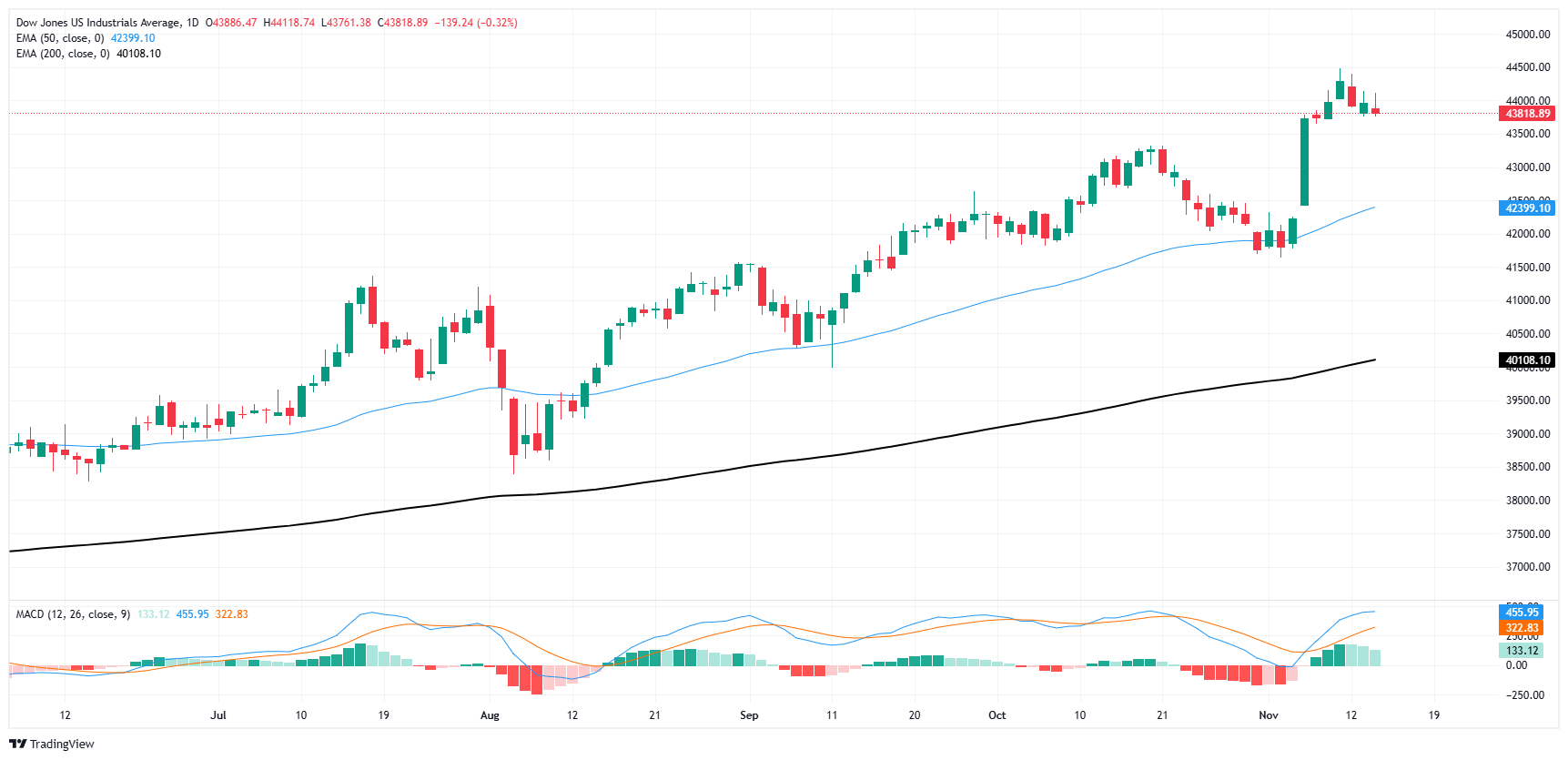- The Dow Jones eased on Thursday as Trump’s election rally is cut short.
- Producer-level prices in the US printed as expected, easing investor concerns.
- Friday brings retail sales data to close out the trading week.
The Dow Jones Industrial Average (DJIA) halted the recent post-election rally that saw a decisive victory for presidential candidate and former President Donald Trump. Investors overwhelmingly perceived the returning White House contender as a pro-market representative within the US government. The stock glut in the election is now fading as stocks pull back slightly from all-time highs.
The Producer Price Index (PPI) producer-level inflation figures came in roughly as expected, despite a slight increase in the annual core PPI numbers. The headline PPI was in line with forecasts in October, rising 0.2% month-over-month compared to the previous month’s revised 0.1%. The annualized core PPI through October accelerated more than expected, rising to 3.1% compared to the expected 3.0%, surpassing the previous period’s 2.9%, which was also revised slightly upward from 2.8 %.
US Retail Sales will be released on Friday and is the last batch of significant US data on the agenda this week. October retail sales are expected to decline to 0.3% monthly from 0.4% previously, while retail sales excluding automobiles are expected to decline to 0.3% from 0.5%.
Dow Jones News
The Dow Jones is roughly balanced on Thursday despite a slight decline in the index’s average price. Half of the stocks that make up the Dow are in the green on the day, with gains led by Walt Disney (DIS). Disney up nearly 7% on the day and tests $110 per share after beating earnings in FY Q4. On the downside, Salesforce (CRM) is down about 2.5% at $333 per share as the AI-powered tech rally takes a pause on Thursday.
Dow Jones Price Forecast
The Dow Jones is struggling to hold the 44,000 level as the major stock index pulls back from all-time highs set just north of 44,400. Downside potential remains limited as the bears have few footholds to hold on to, but a short-term drop to the 50-day EMA near 42,400 cannot be ruled out.
The Dow Jones continues to trend deep into bullish territory despite any near-term drag; The index is on track to close in the green for all but two months in 2024. The DJIA is also trading well above its 200-day EMA near 40,150, with nearly 10% in value between current price action and long-term moving average.
Dow Jones Daily Chart
The Dow Jones FAQs
The Dow Jones Industrial Average, one of the world’s oldest stock indices, is made up of the 30 most traded securities in the United States. The index is weighted by price rather than capitalization. It is calculated by adding the prices of the securities that comprise it and dividing them by a factor, currently 0.152. The index was founded by Charles Dow, also founder of the Wall Street Journal. In recent years it has been criticized for not being sufficiently representative, since it only follows 30 companies, unlike broader indices such as the S& P 500.
There are many factors that drive the Dow Jones Industrial Average (DJIA). The main one is the aggregate performance of its component companies, revealed in quarterly corporate earnings reports. US and global macroeconomic data also contribute, influencing investor sentiment. The level of interest rates, set by the Federal Reserve (Fed), also influences the DJIA, as it affects the cost of credit, on which many companies largely depend. Therefore, inflation can be a determining factor, as well as other parameters that influence the decisions of the Federal Reserve.
The Dow Theory is a method for identifying the main trend of the stock market developed by Charles Dow. A key step is to compare the direction of the Dow Jones Industrial Average (DJIA) and the Dow Jones Transportation Average (DJTA) and only follow trends where they are both moving in the same direction. Volume is a confirmation criterion. The theory uses elements of maximum and minimum analysis. The Dow theory proposes three phases of the trend: accumulation, when the smart money begins to buy or sell; public participation, when the general public joins the trend; and distribution, when the smart money abandons the trend.
There are several ways to trade the DJIA. One of them is to use ETFs that allow investors to trade the DJIA as a single security, instead of having to buy shares of the 30 companies that comprise it. A prominent example is the SPDR Dow Jones Industrial Average ETF (DIA). Futures contracts on the DJIA allow traders to speculate on the future value of the index, and options provide the right, but not the obligation, to buy or sell the index at a predetermined price in the future. Mutual funds allow investors to purchase a portion of a diversified portfolio of DJIA securities, providing exposure to the global index.
Source: Fx Street
I am Joshua Winder, a senior-level journalist and editor at World Stock Market. I specialize in covering news related to the stock market and economic trends. With more than 8 years of experience in this field, I have become an expert in financial reporting.







